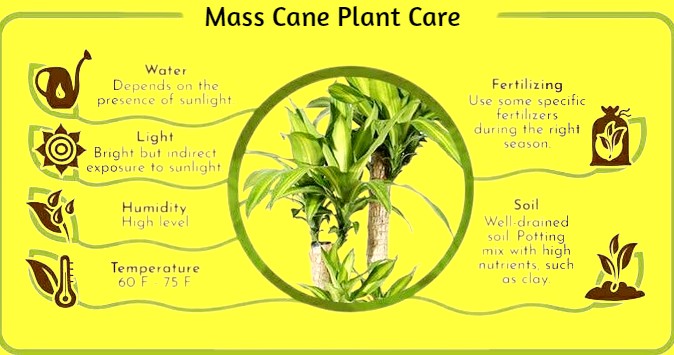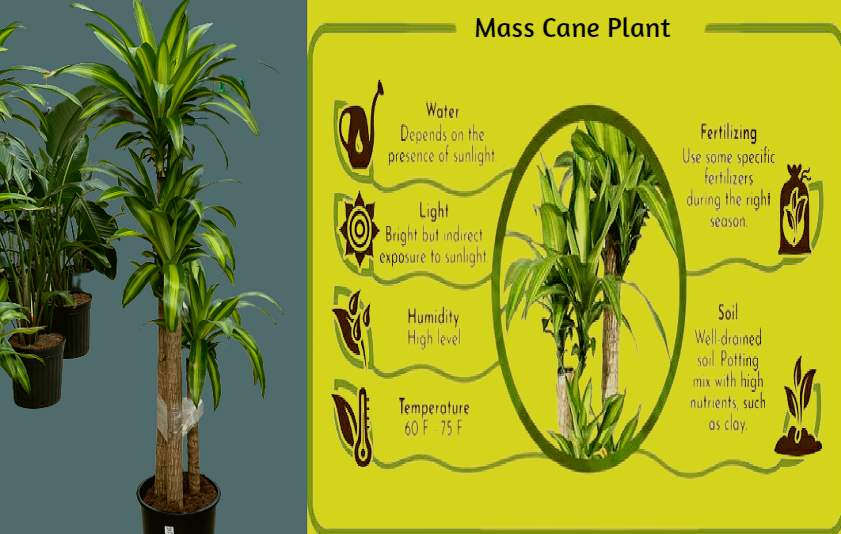A Mass cane plant or corn plant is a type of large Dracaena cultivar that has straight sword-shaped leaves going upward. These corn leaves have straight stripes which resemble Lemon Lime species. This plant grows in Africa but you can cultivate mass cane trees depending on the climatic conditions. Compared to other plants requiring special types of soils, mass cane trees are not picky or selective to live on specific soil. However, you need to make a good plan for nourishing your mass cane plants for have numerous benefits.
Basic Mass Cane Plant Care

Water is the most important component for any tree to survive. Same way, mass cane plantation is incomplete without a touch of water. So, you should be careful how to water this type of Dracaena plant for faster healthcare and smooth growth. Remember a few tricks before you move to do plant care with natural water.
One of the basic conditions to apply water to the plant is to check the water level. Once a week, water the plant. Suffice it to say that you should not drench your small sapling with buckets of water. The soil should be dried enough before the water application. Therefore, you should examine the roots of the trees whether the water level is high or low. To stop water overflow, you must place a tray under the pot for smooth water drainage. It is good for mass cane plant care.
Put Focus on Soil Enrichment for Growth of Mass Cane Trees
Tree plantation depends on many important factors like soil enrichment. If there is an unavailability of nutrients like PH and other minerals, the soil becomes weak. Trees are not able to collect sufficient resources to keep alive. It is necessary to check such deficiencies and enrich the soil for proper tree care. Arrange all essential nutrients and minerals for preparing the soil to plant the cane trees. To end, fluoride is always a negative component for mass cane plants. You should not use tap water containing high levels of fluoride element. The side effect includes the ramification of dark spots on the leaves of mass cane plants. Therefore, you should filtrate water before nourishing trees.
Mass Cane Fertilization
So far as mass cane fertilization is concerned, you should plan accordingly. According to scientists, the fertilizer should be sprayed or blended with the soil once every 14 days in the summer and spring seasons. There is no need to fertilize any cane sapling during the winter season. The application of water-based biodegradable mass cane fertilizer is a must to rejuvenate all young mass cane trees. Perfect the dosage of such chemical solutions as fertilizers to use for the natural growth of cane trees.
No Direct Exposure to Sunlight
Exposure to sunlight should not be direct. You must protect your mass cane plants from the severity of ultraviolet rays. Leaves are burnt to ashes. Try to keep the plants from scorching heat and dust. As a pre-emptive measure, you must install the canopy overhead to resist direct sunlight. On the other hand, you should not block all sides of the shade to check sunlight. There should be a regular flow of air and natural sunlight to make your plants healthy.
Pruning – It is Necessary for the Proper Growth of Mass Cane Plants
Usually, mass cane plants do not need regular or weekly pruning. The leaves of the young sapling remain green and fresh. However, with maturity, the tall trees spread branches, stems, and leaves to make it a mess-up. Dried leaves and stems affect the regular development of the trees. If you need pruning, you should talk to an expert to learn about the process of leave and stem pruning.
How to Save a Dying Mass Cane Plant?
These plants do not need complicated treatment for survival. There are some symptoms of leaves decaying to be indicative of the dying of the plants. Water scarcity, germs, and pests can damage leaves, stems, and other parts of the trees. If you do not take care of your saplings, the risks are there. In the event of yellowish leaves with stray rings or spots, you must spray special insecticide or germicide solutions to stop the faster leave from decaying. Use water that has no toxic acid or fluoride. In this connection, online consultants are helpful for you how to save a dying mass cane plant.
Is Mass Cane Plant Toxic?
Mass cane plants are green and all-natural. The straight leaves of corn plants are strong. However, humans and pets should keep their distance from mass cane plants. Experts have researched to get the answer to the question “Is mass cane plant toxic?” Though mass cane plants are not poisonous for pets and humans, there may be a revelation of basic symptoms of allergies. The pets are sensitive to such allergic reactions caused by exposure to the mass plants. So, you should treat your plants with a few high-quality germicides and anti-microbial solutions to reduce the negative impact of toxicity.
Conclusion
Mass cane plant care saves your trees. All these tips for plant care are useful for you to expand the lifespan of the trees. From water treatment, and soil enrichment, to pruning, you must try to maintain the quality to do the plant care. It can stay in warm climates. In drought-prone areas, mass cane plants are comfortable to grow. You can plant mass cane trees outside your home as well. Through proper mass cane plant treatment, you will be able to rehab your trees properly.
FAQ
Q: Does a mass cane plant require water?
A: For faster growth of the mass cane plants, you should water the trees.
Q: What type of soil is required for the cultivation of mass cane plants?
A: For faster development of mass cane plants, you need to enrich the soil using special fertilizer.
Q: Where to get mass cane plants?
A: In South Africa, mass cane trees are seen in dense forests.
Read More: Maximizing Plant Growth with High-Quality Greenhouse Glass: A Comprehensive Guide

